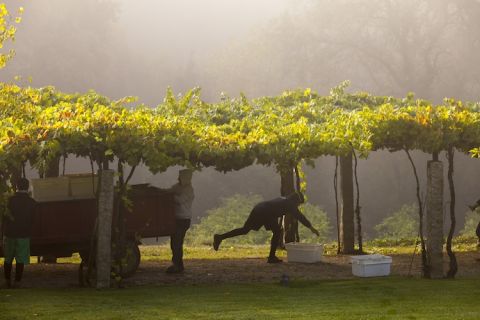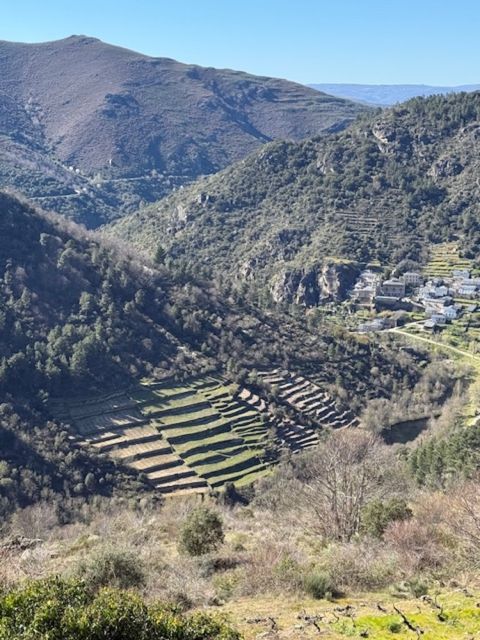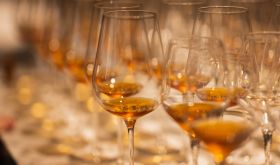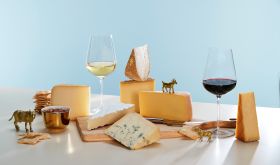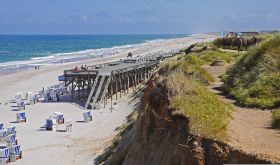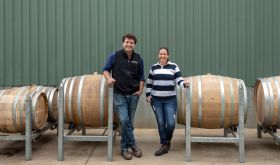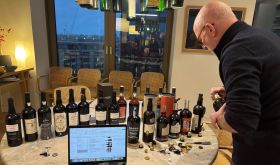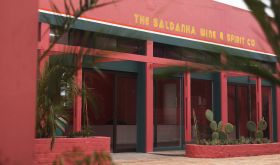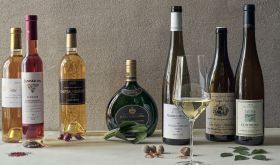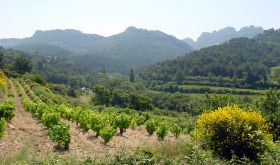Note: In order to deliver this article to you as early as possible, it has been translated with the use of AI. It has been added to a queue for a human translator to fully review and edit. Please pardon any minor translation imperfections while it is being reviewed.
马德里和巴塞罗那在八月份总是留给游客而非当地人,但现在夏季越来越炎热,越来越多的西班牙人选择北上而非南下或东行度过夏日假期。这一趋势的主要受益者是西班牙最湿润、最凉爽、最绿意盎然的地区——位于西北端的加利西亚 (Galicia),这里对葡萄酒爱好者来说也越来越有吸引力。
近年来,加利西亚五个葡萄酒产区中有四个主要生产白酒,见证了世界葡萄酒饮用者从红酒转向白酒的切实、可观的证据,几家重要的西班牙红酒生产商已在加利西亚投资。三年前,坦波斯·贝加西西里亚 (Tempos Vega Sicilia)——位于东南方600公里处最著名的杜埃罗河岸 (Ribera del Duero) 红酒生产商,宣布投资2000万欧元,不仅购买葡萄园,还将在加利西亚主要葡萄酒产区下海湾 (Rías Baixas) 建造一座酒庄,预计明年完工。阿尔玛·卡拉奥韦哈斯集团 (Alma Carraovejas group),另一家备受推崇的杜埃罗河岸生产商卡拉奥韦哈斯庄园 (Pago de Carraovejas) 的所有者,早在2019年就收购了位于内陆稍远处里贝罗 (Ribeiro) 的维尼亚·梅因 (Viña Meín)。重要的里奥哈 (Rioja) 生产商CVNE在2023年收购了下海湾的拉瓦尔 (La Val),早在2002年就在距离其基地最近的加利西亚葡萄酒产区瓦尔德奥拉斯 (Valdeorras) 建立了维尔根·德尔·加利尔 (Virgen del Galir) 业务。杜埃罗河岸的卡佩利亚内斯庄园 (Pago de los Capellanes) 在2015年建立了他们在瓦尔德奥拉斯的酒庄奥·卢阿尔·多·西尔 (O Luar do Sil)。
所有这些外部关注对西班牙这个一直感觉有些孤立、与西班牙主流明显不同的地区来说有些震惊。诚然,下海湾的主要葡萄品种阿尔巴利尼奥 (Albariño) 多年来一直享有时尚的聚光灯。自1990年代以来,它几乎成了西班牙白酒的代名词(而且比下海湾 (Rías Baixas) 更容易发音),即使卢埃达 (Rueda) 的白酒最近构成了更大的挑战。阿尔巴利尼奥厚实的果皮与下海湾戏剧性锯齿状的大西洋海岸线相结合,比西班牙其他地区更多雨水冲刷,产出了清脆、干爽、果香浓郁的早饮葡萄酒,比大多数西班牙白酒更加清爽。
但现在下海湾阿尔巴利尼奥的风格发生了巨大变化,顶级葡萄酒的生产商似乎正朝着某种夏布利 (Chablis) 的方向发展,酿造更有趣的葡萄酒:更具盐分、矿物质、深层风味的葡萄酒,设计用于陈年,非常值得寻找。作为葡萄酒日益严肃的标志,贝加西西里亚 (Vega Sicilia) 的首个年份2024年要到2027年才会发布。该产区已被划分为五个子产区,其中位于海岸边的萨尔内斯谷 (Val do Salnés) 是迄今为止最重要的,也是最湿润的。
加利西亚的一个普遍特征是葡萄园很小,通常由很久以前离开该地区的家庭成员拥有,因此购买土地困难重重。例如,下海湾的4,640公顷(11,466英亩)葡萄园约有16,000个不同的所有者,其中许多分散在全球各地。贝加西西里亚 (Vega Sicilia) 花了四年时间谈判才收购了仅30公顷(74英亩)。该地区分为22,500个地块,为不到200家葡萄酒生产商供应葡萄。每一寸土地都必须发挥作用,花岗岩如此常见,以至于许多葡萄藤都沿着花岗岩柱子攀爬,有时下面还种植其他作物。
在其他加利西亚葡萄酒产区中,里贝罗 (Ribeiro)、里贝拉萨克拉 (Ribeira Sacra) 和瓦尔德奥拉斯 (Valdeorras) 各自拥有略超过1,000公顷的葡萄园,而位于葡萄牙边境的蒙特雷 (Monterrei) 拥有不到700公顷。
米尼奥河 (Miño) 流经里贝罗 (Ribeiro),这里在中世纪时向英格兰供应葡萄酒,然后构成西班牙和葡萄牙之间的边界。它比下海湾干燥得多,其干爽、坚实、通常更有力的白酒,由与葡萄牙绿酒 (Vinho Verde) 大致相同的葡萄酿制,目前正享受着始于1970年代的复兴,当时戈马里斯庄园 (Coto de Gomariz) 的里卡多·卡雷罗 (Ricardo Carreiro) 复兴了当地葡萄品种,特别是特雷伊夏杜拉 (Treixadura)。(雪利酒葡萄帕洛米诺 (Palomino) 曾在加利西亚广泛种植,因为它产量很高,但其葡萄酒远不如基于本土葡萄品种的葡萄酒那样独特,现在基本消失了。)
蒙特雷 (Monterrei) 位于内陆深处,气候比上述受大西洋影响更多的地区更具大陆性气候特征。虽然它主要是一个小型白酒生产商,但也能成熟红酒葡萄,类似于北部里贝拉萨克拉 (Ribeira Sacra) 的葡萄,这是地球上最戏剧性的葡萄酒产区之一。主要是红酒葡萄藤,字面意思上紧贴着西尔谷 (Sil Valley) 的板岩斜坡,坡度可达85%。葡萄栽培能在这里存活真是个奇迹。但像比贝伊酒庄 (Dominio do Bibei) 和蓬特达博加 (Ponte da Boga) 这样的酒庄展示了用当地果香浓郁的门西亚 (Mencía) 葡萄能做什么(这也是位于加利西亚东部边界因此属于卡斯蒂利亚-莱昂而非加利西亚的令人兴奋的比埃尔索 (Bierzo) 产区的主力)。
位于加利西亚极东南角、与比埃尔索 (Bierzo) 接壤的瓦尔德奥拉斯 (Valdeorras) 也位于西尔河上,现在在顶级白酒生产方面有着良好的记录,这要归功于1970年代从近乎灭绝中恢复其极其杰出的戈德洛 (Godello) 葡萄品种。戈德瓦尔酒庄 (Godeval) 的创始人被视为"戈德洛之父",但第一款完全由该葡萄酿制的葡萄酒直到1980年代中期才推出。该品种能酿制如此精致的葡萄酒,具有柑橘矿物质和令人印象深刻的结构,吸引了来自其他地区的西班牙酿酒师的注意。
特尔莫·罗德里格斯 (Telmo Rodriguez),在西班牙各地酿制精品葡萄酒,在1990年代首次意识到加利西亚东部是老藤的宝库。他在2000年奠定了拉德拉斯多西尔 (Ladeiras do Xil) 加利西亚业务的基础,现在在瓦尔德奥拉斯和里贝拉萨克拉拥有25公顷(62英亩)葡萄园,其中九公顷位于极其陡峭的斜坡上,下面的图片显示了其中一些。
拉斐尔·帕拉西奥斯 (Rafael Palacios),阿尔瓦罗 (Álvaro) 的弟弟,后者已因其在加泰罗尼亚普里奥拉特 (Priorat) 的埃尔米塔 (L'Ermita) 葡萄酒而声名鹊起,于2004年到达,并展示了瓦尔德奥拉斯能生产世界上一些最优秀的干白葡萄酒。他的单一葡萄园葡萄酒真正令人惊叹,具有与优质普利尼-蒙哈榭 (Puligny-Montrachet) 相同的结构。他的葡萄园可高达700米(2,300英尺),价格也很高——阿斯索特斯 (As Sortes),他的第一款单一葡萄园装瓶,售价超过60英镑。
不幸但也许可以预见的是,这两位才华横溢的酿酒师都没有被包括在去年年底当地官员组织的一项倡议中,该倡议在伦敦展示了100多款加利西亚葡萄酒(以及一些加利西亚烈酒和利口酒)。实际上,当我将参与者的姓名与JancisRobinson.com团队喜爱的葡萄酒生产商进行交叉核对时,我发现只有下海湾的菲拉博阿 (Fillaboa) 和金塔库塞洛 (Quinta Couselo) 以及里贝罗的戈马里斯庄园 (Coto de Gomariz) 在志愿参与者中。大概这项活动主要是为了给资助它的较不知名的生产商提供帮助。
在品鉴中有一些发现,其中一些是红酒。但如果你正在寻找真正清爽、具有真正特色的白酒,可能会让那些记得厚重西班牙白酒的人感到惊讶,我可以完全推荐这里列出的这些。
加利西亚白酒
拉瓦尔,奥尔巴洛阿尔巴利尼奥 2023 下海湾 (La Val, Orballo Albariño 2023 Rías Baixas) 12.5%
£17 WoodWinters
蓬特达博加,G戈德洛 2023 里贝拉萨克拉 (Ponte da Boga, G Godello 2023 Ribeira Sacra) 12.5%
£21 Talking Wines
芬卡维诺阿 2023 里贝罗 (Finca Vinoa 2023 Ribeiro) 12.5%
£18.50 Terra Wines
帕索蓬达尔,雷拉蓬达尔阿尔巴利尼奥 2023 下海湾 (Pazo Pondal, Leira Pondal Albariño 2023 Rías Baixas) 13%
£20.99 Cockburns of Leith, £20.50 The Good Wine Shop
戈德瓦尔戈德洛 2023 瓦尔德奥拉斯 (Godeval Godello 2023 Valdeorras) 13.5%
£20.50 Les Caves de Pyrène
菲拉博阿阿尔巴利尼奥 2023 下海湾 (Fillaboa Albariño 2023 Rías Baixas) 12.5%
£20 Montrachet
费菲尼亚内斯宫,费菲尼亚内斯阿尔巴利尼奥 2021 下海湾 (Palacio de Fefiñanes, Albariño de Fefiñanes 2021 Rías Baixas) 12.5%
£22 Waitrose Cellar
霍塞·洛伊斯·塞比奥,村庄 2022 里贝罗 (Xosé Lois Sebio, Village 2022 Ribeiro) 13.5%
£22.39 All About Wine
戈马里斯庄园 2023 里贝罗 (Coto de Gomariz 2023 Ribeiro) 13%
£24.30 The Sourcing Table
比贝伊酒庄,拉卢梅 2017 里贝罗 (Dominio do Bibei, Lalume 2017 Ribeiro) 13.5%
£24.99 Thorne Wines
加尔加洛戈德洛 2023 蒙特雷 (Gargalo Godello 2023 Monterrei) 13%
£22.50 L'Art du Vin
特尔莫·罗德里格斯,圣克鲁斯白 2021 瓦尔德奥拉斯 (Telmo Rodriguez, Branco de Sta Cruz 2021 Valdeorras) 13%
£42 Hedonism
拉斐尔·帕拉西奥斯,阿斯索特斯 2021 瓦尔德奥拉斯 (Rafael Palacios, As Sortes 2021 Valdeorras) 14.5%
£62 The Perfect Bottle, £63.50 Songbird Wines, £64 Vino Gusto, £70 Hedonism
品鉴笔记、评分和建议饮用日期见我们的品鉴笔记数据库和加利西亚来到伦敦。国际经销商信息请见 Wine-Searcher.com。 胡尔霍·洛巴托 (Xurxo Lobato) 拍摄了上面的前两张照片。
回到基础
| 清爽白酒是如何酿制的 |
|
我一直认为葡萄酒的首要职责是让你的味蕾感到清爽,让你想要再喝一口。其中的关键成分是酸度,这是柠檬汁和醋的特征。正如我上个月解释的,当葡萄或任何其他水果成熟时,其中的酸度会下降。因此酿制清爽葡萄酒的一个关键是在酸度下降太多之前采摘葡萄。但没有人希望葡萄酒尝起来明显酸涩,葡萄需要积累一些风味(这需要时间),所以任何葡萄种植者最关键的决定是何时采摘。太早,葡萄酒会尝起来平淡无味。太晚,葡萄酒会更有酒精度,可能不再清爽。一个补救办法是向发酵罐中添加酸,通常是酒石酸。
这在较热的葡萄酒产区极其常见,特别是对于较便宜的葡萄酒。但如果添加的酸不要显得突兀,必须非常巧妙地进行。天然酸度通常尝起来更好,即使酒石酸是葡萄中天然存在的最重要的酸。酒石酸的存在是葡萄酒的区别性品质之一,有助于解释为什么葡萄酒比其他发酵果汁能保存得更久。
葡萄和葡萄酒中的另一种主要酸是苹果酸,它比酒石酸尝起来更尖锐——有时过于尖锐。它可以天然存在,但酿酒师经常通过引入特殊的乳酸菌,有时还会加热酒窖来促使它们活跃,鼓励将其转化为更柔和的乳酸。这个过程被称为苹果酸乳酸转化,有时,相当误导性地称为苹果酸乳酸发酵。(会释放出二氧化碳,这在完全理解之前暗示它是一种发酵。)生产商可以通过冷却、过滤或向葡萄酒中添加亚硫酸盐来故意抑制这个过程,以保持葡萄酒的清爽。例如,大多数下海湾生产商避免"苹果酸乳酸转化"。 |


